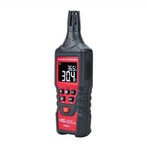Classification methods and categories of electron microscopes
Electron microscopes can be divided into transmission electron microscopes, scanning electron microscopes, reflection electron microscopes and emission electron microscopes according to their structures and uses.
Transmission electron microscopes are often used to observe minute material structures that cannot be distinguished with ordinary microscopes; scanning electron microscopes are mainly used to observe the morphology of solid surfaces, and can also be combined with X-ray diffractometers or electron energy spectrometers to form electron Microprobes are used for material composition analysis; emission electron microscopes are used for the study of self-emitting electron surfaces.
Transmission electron microscope
It is named after the electron beam penetrates the sample and then uses an electron lens to image and magnify the image. Its light path is similar to that of an optical microscope, and it can directly obtain the projection of a sample. By changing the lens system of the objective lens one can directly magnify the image at the focal point of the objective lens. From this one can obtain electron diffraction images. This image can be used to analyze the crystal structure of the sample. In this type of electron microscope, the contrast of image details is formed by the scattering of the electron beam by the atoms of the sample. Since the electrons need to travel through the sample, the sample must be very thin. The thickness of the sample is determined by the atomic weights of the atoms that make up the sample, the voltage at which the electrons are accelerated, and the desired resolution. The thickness of the sample can vary from a few nanometers to several micrometers. The higher the atomic weight and the lower the voltage, the thinner the sample must be. The thinner or lower-density part of the sample has less electron beam scattering, so more electrons pass through the objective lens aperture and participate in imaging, making the image appear brighter. Conversely, thicker or denser parts of the sample will appear darker in the image. If the sample is too thick or dense, the contrast of the image will deteriorate and may even be damaged or destroyed by absorbing the energy of the electron beam.
The resolution of a transmission electron microscope is 0.1~0.2nm, and the magnification is tens of thousands to hundreds of thousands times. Since electrons are easily scattered or absorbed by objects, the penetration power is low, and thinner ultrathin sections must be prepared (usually 50 to 100nm).
The top of the transmission electron microscope barrel is an electron gun. The electrons are emitted from the tungsten filament hot cathode and pass through the first and second condensers to focus the electron beam. After the electron beam passes through the sample, it is imaged on the intermediate mirror by the objective lens, and then is gradually amplified by the intermediate mirror and the projection mirror, and is imaged on the fluorescent screen or photographic dry plate. The intermediate mirror mainly adjusts the excitation current, and the magnification can be continuously changed from dozens of times to hundreds of thousands of times. By changing the focal length of the intermediate mirror, electron microscopy images and electron diffraction images can be obtained on tiny parts of the same sample. .
scanning electron microscope
The electron beam of a scanning electron microscope does not pass through the sample, but only focuses the electron beam on a small area of the sample as much as possible, and then scans the sample line by line. The incident electrons cause secondary electrons to be excited from the sample surface. What the microscope observes are the electrons scattered from each point. The scintillation crystal placed next to the sample receives these secondary electrons and amplifies them to modulate the electron beam intensity of the picture tube, thereby changing the brightness on the fluorescent screen of the picture tube. The image is a three-dimensional image, reflecting the surface structure of the specimen. The deflection coil of the picture tube keeps scanning synchronously with the electron beam on the surface of the sample, so that the fluorescent screen of the picture tube displays the topographic image of the sample surface, which is similar to the working principle of industrial television. Since the electrons in such a microscope do not have to be transmitted through the sample, the voltage at which they are accelerated does not have to be very high.
The resolution of a scanning electron microscope is mainly determined by the diameter of the electron beam on the sample surface. Magnification is the ratio of the scanning amplitude on the picture tube to the scanning amplitude on the sample, and can continuously vary from dozens of times to hundreds of thousands of times. Scanning electron microscopes do not require very thin samples; the images have a strong three-dimensional effect; they can use information such as secondary electrons, absorption electrons and X-rays generated by the interaction between electron beams and substances to analyze the composition of substances.
The construction of scanning electron microscopes is based on the interaction between electrons and matter. When a beam of high-energy incident electrons bombards the surface of a material, the excited area will produce secondary electrons, Auger electrons, characteristic X-rays and continuous spectrum X-rays, backscattered electrons, transmitted electrons, and visible, ultraviolet, and infrared light. electromagnetic radiation generated in the area. At the same time, electron-hole pairs, lattice vibrations (phonons), and electron oscillations (plasma) can also be generated.






